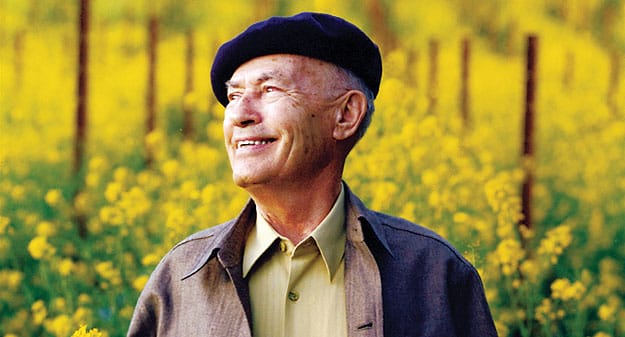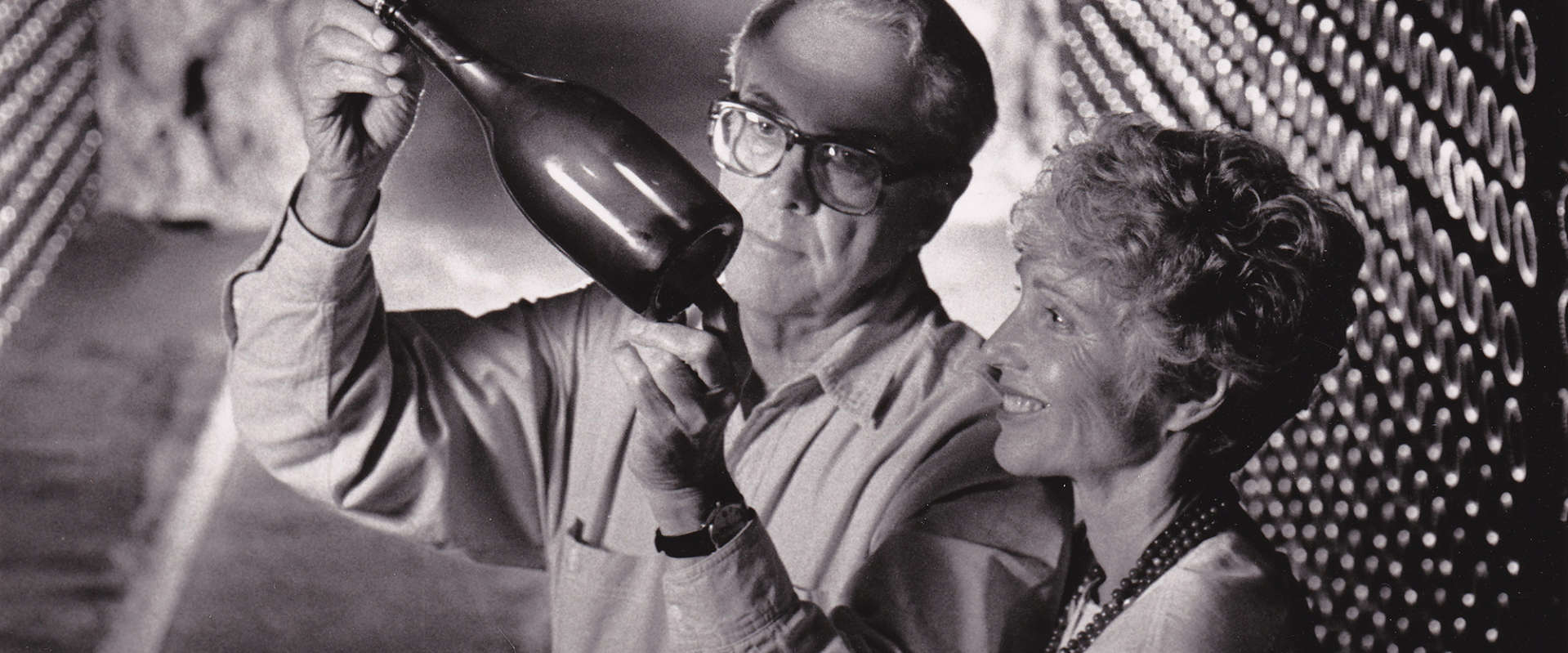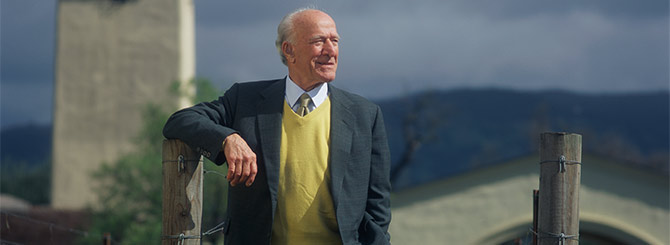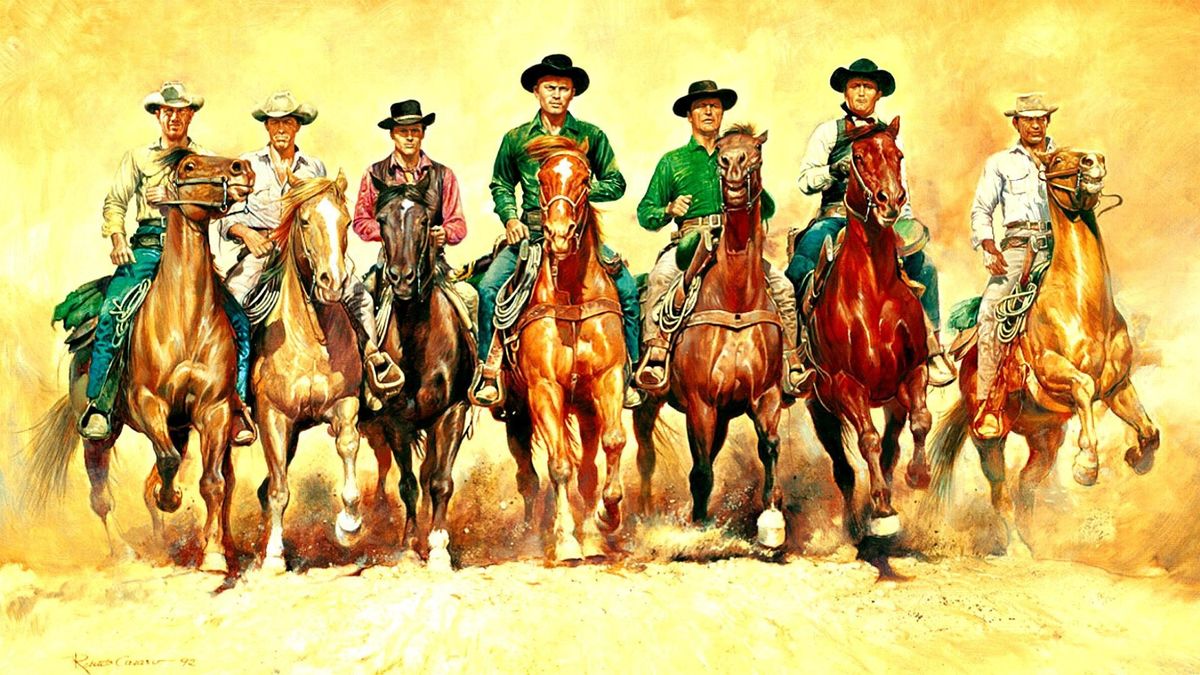
The Magnificent 7
In the last post I discussed the rise of the Gallo wine empire and its significance in re-introducing wine to Americans post prohibition. However, Gallo and its competitors were predominately in the low cost “jug” wine business. The few consumers seeking higher quality were mainly located in the metropolitan east coast and were buying well established European brands. Still, as early as the 1950s a handful of individuals in California were experimenting with French varietals in the quest to make wines of a quality that matched their Euro-rivals. I will focus this post on 7 individuals in particular that set early ground on the state–and indeed world’s–wine renaissance.
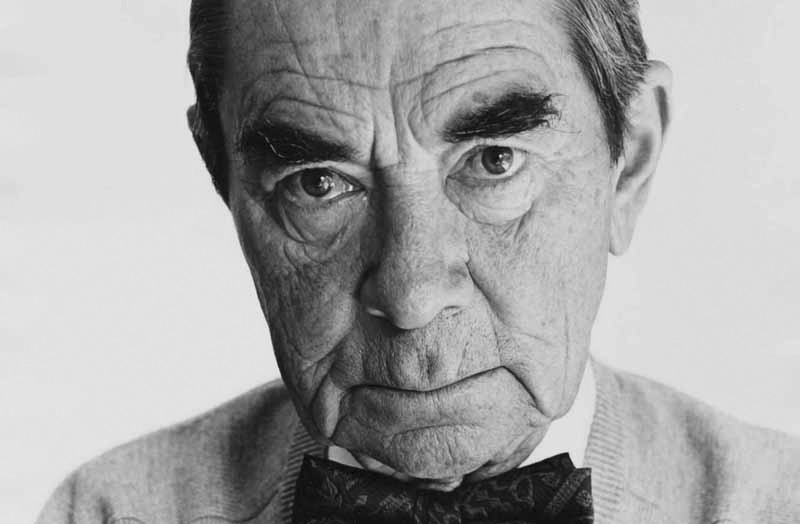
André Tchelistcheff
A discussion of Napa wine history without mentioning the “Maestro” would be equivalent to reciting French history without Napoleon Bonaparte. In Napa his name is as famous as it is difficult to pronounce. Just as it was in the wine boom of the 1850s and 60s, the success of the Californian wine industry would depend on the education and experience brought by immigrants. Arguably, one of the earliest post prohibition premium wine producers in Napa was Beaulieu Vineyards (BV). Established before prohibition, founder Georges de Latour dedicated himself to producing wines that would rival those from his French homeland. Shortly after the repeal, de Latour traveled to France in search of an educated winemaker. The Russian born Tchelistcheff was already being courted by owners worldwide, but de Latour gave him an offer he couldn’t refuse as vice president and chief winemaker at BV.
God made Cabernet Sauvignon, whereas the Devil made Pinot Noir. - André Tchelistcheff
Upon his arrival in 1938, Tchelistcheff put an immediate focus on Cabernet Sauvignon paying particular attention to nuances of the grape’s development in the relatively warm, dry climate of Napa Valley. However, his real contributions to the California wine industry didn’t start until after Latour’s death in the 1950’s. Georges’ widowed wife Fernande proved less interested in making wine than making money and stifled many of Tchelistcheff’s efforts to improve quality. Frustrated, André began assisting other winemakers in the valley including Mike Grgich, Joe Heitz, and Robert Mondavi. After retiring from BV in 1973 he became a consulting enologist for Jordan Vineyard and ran his own private wine lab offering advice extending out to new up-and-coming regions in Oregon and Washington. André’s contributions and accolades are too many to list, but here are some notables:
- Noted the advantages of cold fermentation as it relates to the acidity and fruitiness of a wine.
- The first winemaker to use American oak.
- Helped develop ways to control malolactic fermentation.
- Studying, developing many US wine regions including Carneros, Willamette Valley, and Columbia Valley.
- Recognized by Wine Spectator in 2000 as “The Person Who Has Done the Most to Advance Wine Quality.”
Lee Stewart
J. Leland Stewart never like the pretense of having lineage to the Lelands of Stanford University fame, which is why he went simply by the name “Lee”. In 1943 he bought thirty acres of land on Napa’s Howell mountain for the purpose of agriculture. However unlike his prune-producing neighbors, Lee’s desire was to plant vines and start a winery that he would name Chateau Souverain (a play on the French “sovereign”). Without the benefit of any experience or education in viticulture or enology Lee relied predominately on observations and experimentation–with a sharp focus on consistency. In the lore of Napa wine personalities Lee Stewart is arguably the least known, but I find him an integral part in what were the earliest days of modern wine history. As other aspiring–and often clueless–wine makers arrived in Napa in the 1960s, they could look to Lee as one of the few able to offer them advice. His willingness to do so, along with André Tchelistcheff, Louis Martini, and Robert Mondavi fostered a trend of collaboration over the years to come that would be a key to Napa’s success vs. other regions. Lee’s biggest claim to fame was his hiring of Mike Grgich, immigrating him to the US, and thus launching the career of what would be another Napa legend. However, he deserves many other lesser known accolades:
- Introduced and named varietal Petit Sirah (later recognized as French varietal Duriff).
- Early advocate of “clean wine making practices” introducing hygienic practices that would only be adopted around the world decades later.
- Championed Martin Ray’s philosophy of single-varietal winemaking.
- Outspoken proponent of practicing the French standard of fermenting Chardonnay sur-lee in oak barrels.
- By 1963 Chateau Souverain would win 93 medals at the California State Fair. Then the standard for judging quality California wine.
Mike Grgich
Well known as an irascible curmudgeon from Croatia, the name Mike Grgich (Miljenko Grgić) seems to be at the center of any major conversation in the wine industry throughout the second half of the 20th century. Like his mentor Tchelistcheff, his route to the US was circuitous coming from war-ravaged and communist Eastern Europe. First hired by Lee Stewart at Chateau Souverain, Grgich went on to work for Tchelistcheff at BV, then Chateau Montelena, Christian Brothers, and Robert Mondavi before partnering with Austin Hills (Hills Brothers Coffee) to start his own winery Grgich Hills. In the 80’s and 90’s Grgich was recognized as one of the “big 3” Chardonnay producers along with Far Niente and ZD Wines. Together they set the standard for a style of richness that set Napa apart. Recently, Grgich’s contribution to the famous Chardonnay that won the Paris Wine Tasting of 1976 was omitted by the movie Bottle Shock. The movie falsely portrayed owner/partner Pat Barret as the winemaker. Although, initially consulted by the movie’s producers, rumor has it Grgich’s famously abrasive behavior got him written out of the script. Of the 5 people I mention in this post Grgich is the soul survivor at 95 and is easily recognizable wearing his signature beret. Like Tchelistcheff, Grgich’s accolades are overwhelming, but here’s just a few:
- Winemaker of the winning Chardonnay in the famous Paris Wine Tasting of 1976.
- His first vintage at Grgich Hills won the 1980 Chardonnay Showdown over 221 entries.
- Inducted into the Culinary Institute’s Vintner’s Hall of Fame
- James Beard Award winner
Louis P. Martini
In his youth the shy, introverted Louis P. Martini stood in the shadow of his gregarious bigger than life father Louis M. Martini. Louis M. followed the same risks and path of Cesare Mondavi during prohibition by getting out of the grape business and into winemaking. Louis M. always believed prohibition was an aberration and so started his winery in 1922. Son Louis P. took over in 1946 and set about focussing on making high quality wine. Luckily, his father had purchased some choice acreage around Napa and bordering Sonoma to work with, including Monte Rosso on the back side of Mt. Veeder which, IMHO produces some of the best Cabernets. Starting in 1962 Louis P. ventured further a field east to Chiles Valley and Carneros in the south. Carneros, in particular, was frowned upon as a wine region at the time. However, around 1973 Louis P. started to recognize the success of Pinot Noir in his Carneros vineyards. At that time Pinot was commonly grown along with Zinfandel and Cabernet in the hotter Napa Valley. Then, California Pinot was gritty and heavy in body like any other red. Martini was one of the first to recognize it’s elegance when grown in cooler climates like the foggy bay-hugging Carneros district. Today, Carneros is the only region where Napa County still grows Pinot Noir. Both father and son were active in their small Napa wine community. Louis M. helped found the Napa Valley Vintners Assoc. Louis P. served on the Wine Advisory Board. Both were advocates for collaboration in the valley. Here are some of Louis P.’s accomplishments:
- First to plant grapes in Carneros.
- First to produce a vintage Merlot in California.
- Early advocate and grower in the Sonoma’s Russian River Valley.
- Early proponent of mountain vineyards.
- Inducted into the Culinary Institute’s Vintner’s Hall of Fame.
Jack Davies
While it’s not surprising that a high society couple out of Beverly Hills might have a taste for Champagne, it’s arguable whether they would have the grit and wear-with-all to actually make it. Jack and Jamie Davies were partners and I am being remiss—if not sexist—for omitting Jamie’s name from the header, but this is a post about individuals and Jack was the winemaker. The Davies were bit by the “back to nature” bug and in 1965 bought an old ghost winery once owned by a German immigrant named Jacob Schram back in the late 1800’s. Unlike most old wineries, this one was unique in that Schram had hewed a cave into the Diamond Mountain hillside property. This suited Jack as he was not here to make still wines like most of his neighbors. The Davies were interested in making sparkling wine that rivaled vintage Champagne. This meant growing the same grapes, adhering to Champagne’s Methode Traditionale winemaking process, and riddling/aging wine in caves. Despite his ambitions, Jack was not an accomplished winemaker. Luckily, neighbors like Louis Martini, André Tchelistcheff, and the Mondavi brothers were so enamored with the idea of world class sparkling being made in Napa Valley they chipped in to help Jack figure it out. Initially word was slow, but steady, producing 1,000 cases by 1970. Fortunes changed in 1972 when California native Richard Nixon carried 25 cases to China to celebrate the return of diplomatic relations there. An act that has made Schramsberg a mainstay in the White House cellar to this day. The next California president, Ronald Reagan, was known to serve it to congressional easterners and jokingly challenge them to find a better wine in France. The Davies’ success story of making quality sparkling wine in California eventually got out to Europe which sparked a buying spree of Carneros land by famous French cellars like Tattinger, Moet & Chandon, Mumm, and Spanish Cava producer Cordoníu. The Davies were not the first to make sparkling wine in California…they just set the standard. They were also active in other fronts regarding Napa Valley. Here are some of their accomplishments:
- First to plant Champagne varietals/clones in Napa.
- First to produce sparkling wine in California using Champagne’s traditional method.
- First to produce vintage Blanc de Noirs (1967)
- Leaders in the movement to declare Napa Valley an agricultural perserve.
- Successfully helped stop the widening of highway 29 from 2-to-4 lanes.
- Schramsberg has been served at White House events by every President since 1972.
Robert Mondavi
Of the 7 mentioned here, none are arguably more famous than Robert Mondavi…and Robert wouldn’t have it any other way. Mondavi was an excellent winemaker in his own right, but his real skills and contribution to the wine industry were in marketing. While everyone else was in the pursuit of creating high quality wine, Robert was obsessed with how sell it to the masses. Even though Robert’s contributions to the wine industry really didn’t erupt until the 1970s I include him in this list because it was his early marketing vision in the 1960s that helped future wineries find consumers beyond their tasting rooms. Mondavi is the father of a vision that fine wine should be a part of everyday American life. Elevating people to aspire beyond the jug. To say Robert was restless would be an understatement. Born in Lodi, CA Robert and his brother Peter helped their grape-growing father Cesare start a new venture after buying Charles Krug Winery in St. Helena. By 1946 CK Mondavi had established a reputation for producing affordable everyday wines. However, after their father’s death in 1959 the brothers grew contentious. While Peter believed in his father’s vision Robert had higher aspirations. By 1965 their infamous feud had exploded with Robert leaving the winery in a controversial manor to start his own Robert Mondavi Winery. Robert immediately started spending and borrowing to fund his ambitions. A practice that kept him in debt the rest of his life. However, no expenses were spared. Robert always purchased the best equipment and his modern winery and tasting room built in 1966 began an opulent Vegas-like building boom that continues today. The same attention was spent on his wine in consulting Andre Tchelistcheff and ultimately hiring Mike Grgich. However, Robert’s ambitions would eventually get the best of him resulting in an embarrassing sale of his winery and name to Constellation Brands. even still, his legacy is revered and his accomplishments are many. Here are but a few:
- Revived the unpopular Sauvignon Blanc by aging it in oak and selling it under the name “Fumé Blanc.” A practice so successful many other winemakers across the state followed suit and the made up nomer continues to this day.
- Stopped the decline of the maligned Zinfandel by introducing it to French oak and selling on par with the more popular Cabernet Sauvignon. Although, Napa vintners continued to replace their Zin with Cab, Sonoma vintners followed Robert’s example and kept Zin as their cult favorite.
- By establishing his Woodbridge brand with a large production facility in Lodi, Mondavi brought 750ml premium Napa wine to the masses.
- Partnered with Baron Philippe de Rothschild of Chateau Mouton Rothschild fame to found Opus One–which quickly became one of the Napa’s first cult Cabernets.
- Contributed millions of dollars to UC Davis’ enology and viticulture programs helping feed the growing demand for educated winemaking and vineyard staff throughout the US.
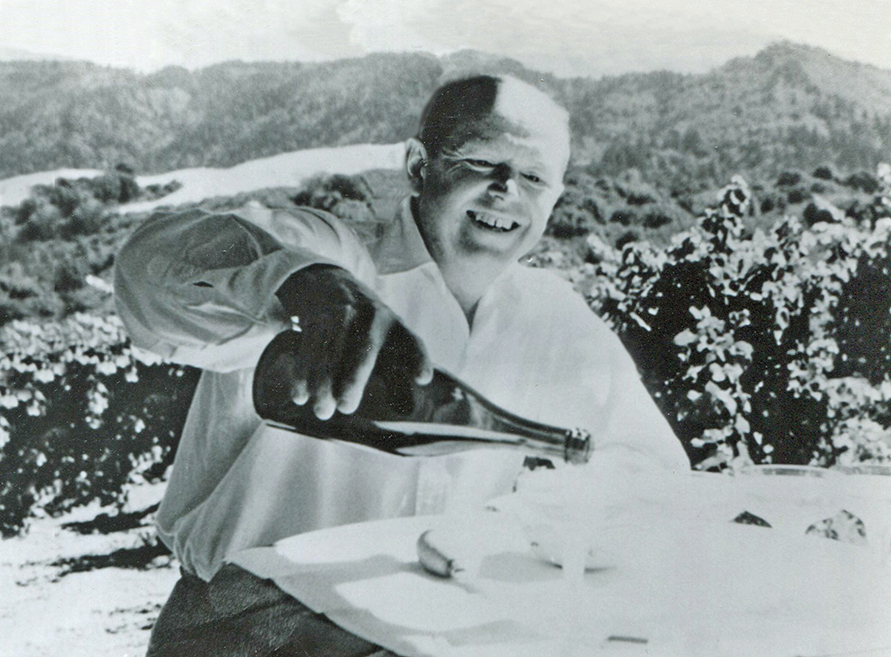
Martin Ray
This is a series about Napa vs. Sonoma. This post is about early pioneers of the modern wine era. The first 6 mentioned operated in Napa Valley. This, the 7th and final, did not. Nor did he in Sonoma. Martin Ray hails from the region I first discovered wine and still hold very dear–the Santa Cruz Mountains. Martin Ray makes this list because way back in 1936, even before Lee Stewart, he was an outspoken advocate of single varietal wines and varietal labeling. At a time when bulk wine producers were producing wines like California Chablis and Hearty Burgundy (neither of which had much, if any, of their French namesake grapes), Ray was adamant that wines should be 100% varietal and labeled as such. Surprising, since his mentor was none other than Paul Masson, a successful bulk producer who ironically sold his vineyards to Ray. Eventually Ray’s vision caught on. Not just in the Santa Cruz Mountains, but all over California. Bombastic, boastful, eccentric, and perhaps a bit crazy, Ray was famous for lavish parties and outlandish statements. His wine was adored by critics, but expensive and hard to get. Ray’s antics eventually got him forced out of the business by his financial partners in 1972, but his vision on how wine should be produced and labeled actually became law in 1982. Although I have no professional accolades for Martin Ray, I shiver at the prospect of rows of bottles being labeled “California Red Wine.”
Conclusion
In this post I chose 7 individuals who were pivotal in California’s movement to produce quality wine beyond the then current “jug” standard. Admittedly, my selection is subjective. However, one thing is fairly obvious…6 out of 7 operated in Napa Valley. Oh, Sonoma was producing quality wine in the early days, but with less vigor. In fact, heavily funded Hanzell Winery near downtown Sonoma had become a virtual experimentation lab frequented by some of the pioneers mentioned in this post. Still, there weren’t the personalities, collaboration, and vision that was going on in Napa at the time. The Delingers, DeLoach’s, Bynums, Strongs, Stares, would all come later. But at the end of the 1960’s, thanks to winemakers like my magnificent 7, the modern wine era had emerged. In my next post we will find out how a Federal farm bill, an ambitious winemaker, and an investment-seeking bank touched off a wave of new California vintners known as the Class of ‘72.

